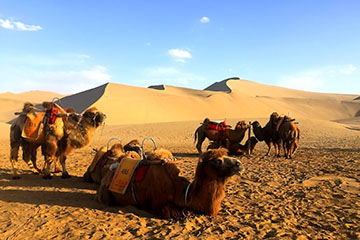Name in Chinese: 陕西 Shǎn Xī [sæʃɪ]
Location: Northwestern China, GMT+8
Population: 38.76 million
Reputation: the Cradle of Hua-xia(Chinese) Civilization
Overview
Shaanxi is a province in the hinterland of Northwestern China. It is well-known as the cradle of Hua-Xia Civilization. Hua-Xia refers to the tribes which lived in the Yellow River Basin. The civilization developed along the Yellow River has nurtured a splendid history and culture in Shaanxi Province. Shaanxi is contiguous to some Chinese provinces, namely, Sichuan, Chongqing, Hubei, Henan, Shanxi, Inner-Mongolia, Ningxia and Gansu. With a population of over 38 million, the province covers an area of 205,600 square kilometers(79,383 sq.mi). It is divided into ten prefectures, including Xi’an, Xianyang, Baoji, Weinan, Yan’an, Tongchuan, Hanzhong, Yulin, Ankang and Shangluo. Xi’an is the capital city of Shaanxi Province, is the most important aviation hub in Northwestern China. The city is of special historic interest. It used to be the capital of ancient China in thirteen dynasties, such as the Western Zhou Dynasty(1046B.C.-771B.C.), the Qin Dynasty(221B.C.-207B.C.), the Western Han Dynasty(202B.C.-8A.D.) and the Tang Dynasty(618-907). There are many places of interest in Shaanxi Province. The top four attractions in Shaanxi are the Terracotta Warriors, Huashan Mountain, the Mausoleum of the Yellow Emperor and Famen Temple.
Attractions:
The Terracotta Warriors
The site of the Terracotta Warriors is located 40 kilometers(25 miles) to the east of downtown Xi’an. There are over 8,000 life-size statues in three vaults. The warriors, horses and chariots are lined up and divided into cavalry and infantry units. All the statues were made and buried over 2,000 years ago. In March, 1974, some peasant farmers discovered several statues of warriors, when they were digging a well nearby the site. They reported the discovery to the government. Then, some archaeologists came and unearthed the vaults. The statues served as the funerary items for Emperor Qin-Shihuang, the first emperor in Chinese history. As one of the top three attractions in Mainland China, the assemblage of Terracotta Warriors and Horses has been billed as the Eighth Wonder of the World and added to the list of world cultural heritage sites by UNESCO in 1987.
Huashan Mountain
Huashan Mountain is one of the most famous mountains in China. It is also known as the West Mountain. The mountain lies about 120 kilometers(75 miles) to the east of Xi’an. It is a holy land of Taoists and a wonderful destination for hikers. The summit of the mountain is called the South Peak, is 2,155 meters(7,070 feet) above sea level. Huashan Mountain is famed for its precipitous cliffs. It is quite difficult for visitors to hike. The plank walkway hanging on the cliff is considered as the most fearsome path in the world. However, the scenery on the mountain top is incredibly magnificent.
The Mausoleum of the Yellow Emperor
The Mausoleum of the Yellow Emperor is called Huangdi-Ling by Chinese. It has been the site for Chinese people to worship the Yellow Emperor since ancient times. Chinese history begun with two legendary figures, the Yellow Emperor(or Emperor Huang) and the Red Emperor(or Emperor Yan). They were chieftains of the two tribes which inhabited in the Yellow River Basin in the years of around 3000 B.C.. The two tribes gradually melted into one in the following centuries. That’s the reason why Chinese people always call themselves “the descendants of Yan and Huang”. The mausoleum is located in Huangling County, about 170 kilometers to the north of Xi’an. It is a national five-star scenic area.
Famen Temple
Famen Temple was founded during the reign of Emperor Huan and Emperor Ling(146-189). It has a long history of over 1,800 years. The temple houses a large number of historical curiosities. One of them is the Sarira of Buddha Sakyamuni. Famen Temple is a national five-star scenic area. It is situated in Fufeng County, around 110 kilometers(68 miles) to the west of Xi’an.
Climate
Shaanxi Province features the subtropical climate. It has a warm spring, a rainy summer, a cool autumn and a cold winter. The average temperature in Xi’an Province ranges from 1℃(33.8°F) to 10℃(50°F) in spring, 17℃(62.6°F) to 28℃(82.4°F) in summer, 22℃(71.6°F) to 32℃(89.6°F) in autumn, and 5℃(41°F) to 14℃(57.2°F) in winter. The best time to travel to Shaanxi is between April and October.
How to Get to Shaanxi
Xi’an is the most important aviation hub in Northwestern China. By the end of 2019, more than 100 domestic air routes and 70 internationals have been operating in Xi’an. The network covers Europe, North America, and Oceania with linked destinations around the world, such as Paris, Prague, Madrid, Melbourne, Los Angeles, San Francisco, etc. Travelers can fly to Xi’an from Beijing, Shanghai, Guangzhou, Chengdu and some other cities within Mainland China. They can also travel to Xi’an by bullet train from Beijing, Chengdu or Chongqing.
Author: Tina Luo
Update:

